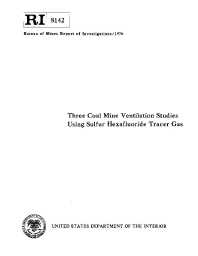Mining Publication: Three Coal Mine Ventilation Studies Using Sulfur Hexafluoride Tracer Gas
Keywords:
Original creation date: January 1976
This report describes three coal mine ventilation studies by the Bureau of Mines in which sulfur hexafluoride (sf6) was used as a tracer gas. One of these studies was conducted to determine air movement and leakage in a sealed area. Another was run to determine the ventilation efficiency of a bleeder system. Finally, a study was made of air leakage across permanent stoppings of parallel intake airways. These studies proved sulfur hexafluoride to be a useful addition to the equipment commonly used in coal mine ventilation analysis.
Authors: RP Vinson, FN Kissell
Report of Investigations - January 1976
NIOSHTIC2 Number: 10000745
Pittsburgh, PA: U.S. Department of the Interior, Bureau of Mines, RI 8142, 1976 Jan; :1-19
See Also
- Bleeder System in Virgin Area in a Pittsburgh Coalbed Mine
- Bleederless Ventilation Systems as a Spontaneous Combustion Control Measure in U.S. Coal Mines
- Demonstration of Safety Plugging of Oil Wells Penetrating Appalachian Coal Mines
- Diesel Aftertreatment Control Technologies in Underground Mines: The NO2 Issue
- The Effects of Water Spray Placement for Controlling Respirable Dust and Face Methane Concentrations
- Methods to Improve Efficiency of Mine Ventilation Systems
- Methods to Improve Mine Ventilation System Efficiency
- Sulfur Hexafluoride as a Mine Ventilation Research Tool - Recent Field Applications
- Three Coal Mine Gob Degasification Studies Using Surface Boreholes and a Bleeder System
- Tracer Gas as an Aid in Mine Ventilation Analysis
- Content source: National Institute for Occupational Safety and Health, Mining Program


 ShareCompartir
ShareCompartir
